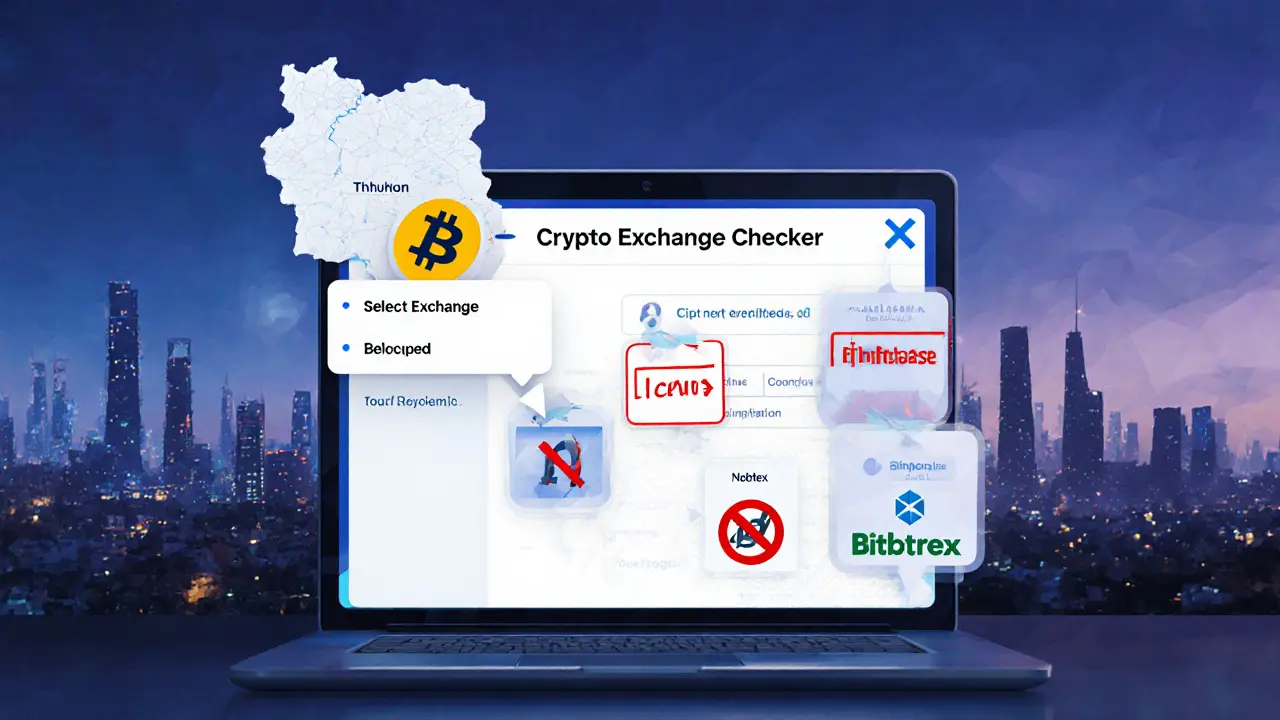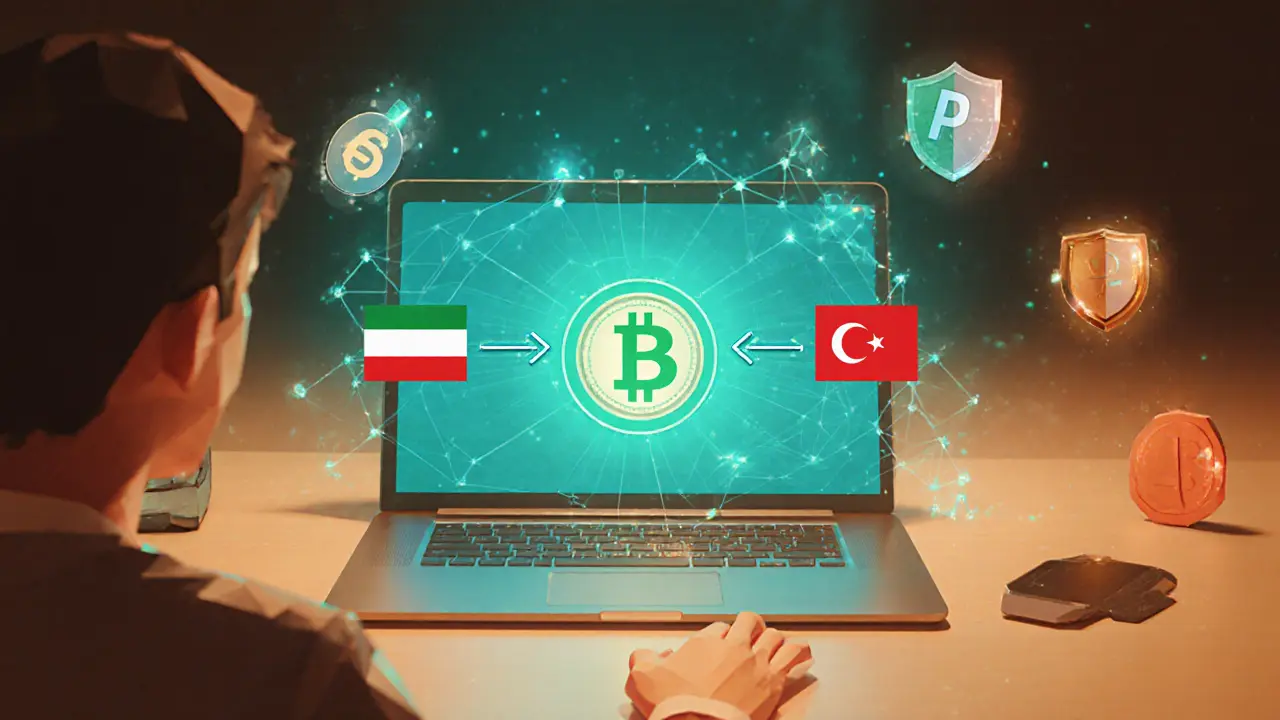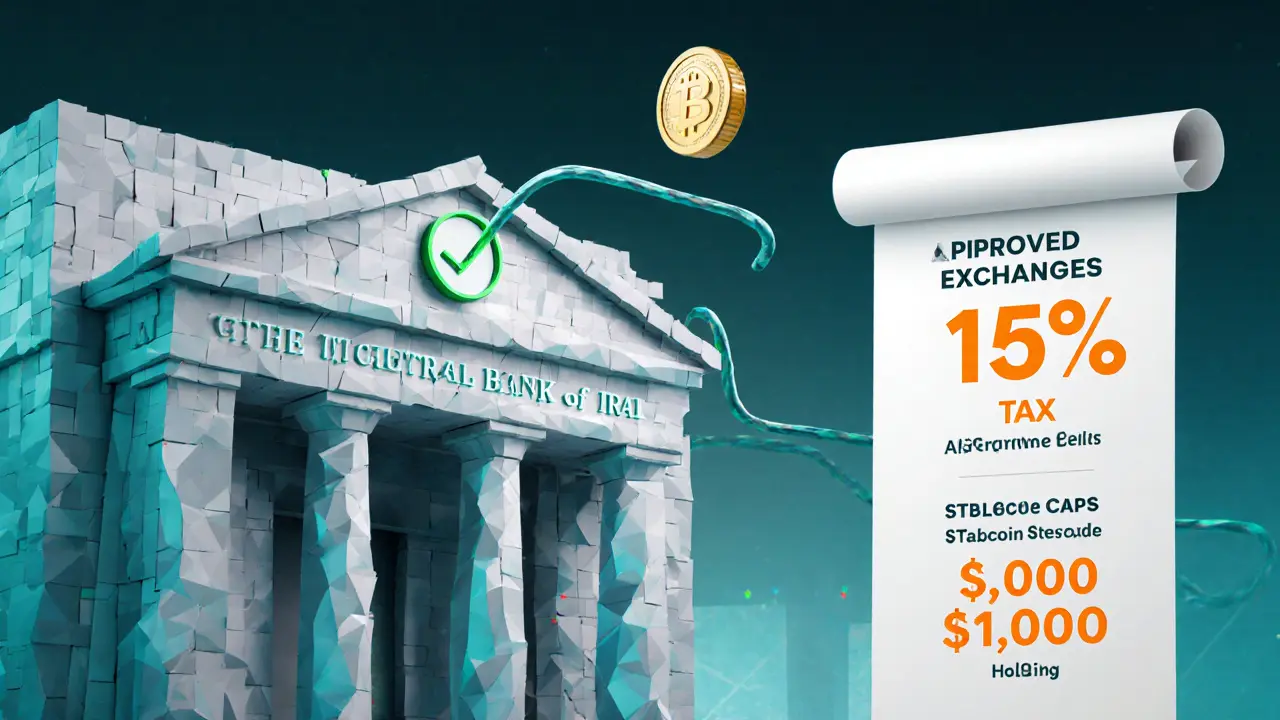Crypto Exchanges Banned in Iran - 2025 Restrictions Explained
 Oct, 26 2024
Oct, 26 2024
Iran Crypto Exchange Checker
This tool helps you understand whether popular crypto exchanges are accessible to Iranian users based on 2025 regulations and sanctions.
Exchange Status Legend
Iranian crypto users face a tangled web of rules, sanctions, and sudden freezes that make it hard to know which platforms are actually off‑limits. In 2025 the government tightened domestic controls while foreign services pulled the plug to stay compliant with U.S. sanctions. If you’ve ever wondered which exchanges you can’t use from Tehran, this guide breaks down the why, the who, and the workarounds you need right now.
Quick Take
- The Central Bank of Iran now only allows crypto‑to‑fiat trades through a government‑run API; any exchange outside that system is effectively blocked.
- Major foreign services such as Binance, Coinbase and Kraken block Iranian IPs because of OFAC sanctions.
- Domestic giant Nobitex remains operational but is under heavy scrutiny - Tether froze dozens of wallets linked to it.
- Stablecoin purchases are capped at $5,000 per year and holdings at $10,000 per person.
- Users increasingly route trades through Turkey or use alternative stablecoins like DAI on Polygon to sidestep freezes.
Domestic Regulatory Landscape
On Iran a Middle‑Eastern nation under heavy U.S. sanctions, governed by an elected President and a powerful Supreme Leader the key regulator for crypto is the Central Bank of Iran the state institution that controls monetary policy and oversees financial institutions. After years of “tolerated” crypto activity, the bank issued a sweeping decree on 27December2024 that halted all direct crypto‑to‑rial exchanges on public websites.
In January2025 the bank softened the stance, but only for platforms that plug into its new API. The API forces exchanges to share full user data - names, transaction histories, even wallet addresses - with the central bank. Any exchange that refuses this level of transparency is blocked, meaning that most foreign services cannot legally operate inside Iran. The government also slapped limits on stablecoins. Deputy Governor Asghar Abolhasani the senior official overseeing Iran’s banking compliance announced on 27September2025 that individuals may buy no more than $5,000 worth of stablecoins annually and hold a maximum of $10,000 at any time. The rule targets USDT, USDC and other dollar‑pegged tokens that are the most common bridge to global markets. Advertising restrictions arrived in February2025: any promotion of crypto - online, on TV, or in print - is now illegal. The move signals a broader intent to curb public awareness and adoption, reinforcing the idea that crypto is a “controlled” commodity rather than a free market asset. Finally, August2025 saw the first ever capital‑gains tax on crypto trading, aligning digital assets with gold, real estate, and foreign exchange. The tax is modest (15% on profits) but adds another layer of compliance for anyone trading on local platforms.
International Sanctions and Their Ripple Effects
The United States, through the Office of Foreign Assets Control (OFAC the Treasury department unit that administers and enforces economic sanctions), has been tightening the screws on Iran’s crypto channels since 2023. In 2024 OFAC released 13 new designations that included specific cryptocurrency addresses, a record number for the past seven years. The designations effectively outlaw any U.S. person or entity from dealing with those wallets.
One of the biggest blows came on 2July2025 when Tether the issuer of the USDT stablecoin, operating under a U.S. corporate structure froze 42 Iranian‑linked addresses, many of which had heavy transaction volume through Nobitex Iran’s largest centralized cryptocurrency exchange, handling a majority of domestic crypto traffic. The freeze cut off tens of millions of dollars in USDT, forcing users to scramble for alternatives.
Other foreign exchanges complied voluntarily or under legal pressure. Bittrex a U.S.‑based exchange that filed for bankruptcy in 2024 but still processes legacy accounts froze Iranian accounts after a U.S. sanctions notice, leading to an $88million lawsuit from an Iranian plaintiff that was ultimately dismissed on technical grounds.
Even major platforms that never officially operated in Iran, like Binance, Coinbase, and Kraken, now block Iranian IP ranges and require KYC documents that Iranians cannot legally provide. The result is a de‑facto ban on most reputable foreign exchanges for Iranian residents.

Exchanges Directly Affected
Below is a snapshot of how the two main categories of exchanges - domestic and foreign - are currently treated under Iranian law and U.S. sanctions.
| Exchange | Type | Regulatory Status in Iran | U.S. Sanctions Impact | Typical Workaround |
|---|---|---|---|---|
| Nobitex | Domestic | Operates via Central Bank API - fully monitored | Subject to Tether freezes, IRGC address scrutiny | Swap USDT to DAI on Polygon, then move off‑chain |
| Binance | Foreign | Blocked - IP and KYC restrictions | OFAC compliance forces account bans | Use VPN + Turkish residency for account creation |
| Coinbase | Foreign | Blocked - no official service | U.S. sanctions prohibit serving Iranian users | Convert crypto to DAI, then trade on local P2P markets |
| Bittrex | Foreign (bankrupt) | Accounts frozen, cannot access funds | Sanctions‑driven freeze of Iranian holdings | Legal claim process - low success probability |
How Users Are Getting Around the Blockades
Even with the choke points described above, Iranian traders have found ways to stay in the market. The most common approach is a two‑step swap: move USDT out of a blocked exchange, convert it to a less‑targeted stablecoin (often DAI), and then route the DAI through a low‑profile network like Polygon. Polygon’s lower fees and high transaction speed make it ideal for quick swaps that don’t attract the attention of OFAC monitors.
Turkey has emerged as a preferred gateway. Its crypto‑friendly regulations, dollar‑based economy, and straightforward e‑residency programs let Iranians open accounts on Binance or Kraken without raising immediate red flags. Once a Turkish account is live, users can fund it via P2P platforms that accept Iranian rial in exchange for Bitcoin or Ethereum, then trade those assets on the foreign exchange.
Some traders also resort to decentralized exchanges (DEXes) that don’t require KYC. By using wallets like MetaMask, they can connect directly to Uniswap or PancakeSwap, swapping USDT for DAI, then bridging to Polygon. The trade‑off is higher gas costs and the need for more technical know‑how, but it sidesteps the centralized bans entirely.
Checklist for Iranian Crypto Participants
- Verify if an exchange is integrated with the Central Bank API - only those are legally usable inside Iran.
- Keep stablecoin purchases under $5,000 per year and holdings under $10,000 to avoid government penalties.
- Use a reputable VPN and, if possible, a Turkish residency or e‑visa to open accounts on major foreign exchanges.
- Prefer DAI on Polygon for cross‑border swaps; it’s less likely to be frozen by Tether.
- Maintain a record of all transactions - the new taxation law requires reporting of crypto profits.
- Stay updated on OFAC designations - a newly listed address can instantly freeze your funds.
What to Watch for in the Coming Months
Policy shifts are happening fast. Expect tighter caps on stablecoins as the Central Bank tries to curb capital flight, and watch for new OFAC designations that could freeze additional wallets. The Iranian government may also roll out a domestic digital rial‑backed token, which could divert traffic away from foreign stablecoins entirely. Keeping an eye on official announcements from the Central Bank’s website and OFAC’s sanctions list will give you the earliest warning.

Frequently Asked Questions
Is Binance completely blocked for Iranian users?
Yes. Binance blocks Iranian IP addresses and requires KYC documents that Iranian residents cannot legally provide. Some users bypass the block with a VPN and a Turkish residency, but this violates both Binance’s terms and international sanctions.
Can I still use Nobitex after the Tether freeze?
Nobitex remains operational, but any USDT you hold may be at risk of freezing if it traces back to the 42 addresses Tether blocked. Users are advised to convert USDT to DAI on Polygon or move funds to a foreign exchange via a Turkish account.
What are the stablecoin limits imposed by the Iranian central bank?
Each individual or legal entity may purchase up to $5,000 worth of stablecoins per calendar year, and the maximum balance any user can hold at any time is $10,000. Exceeding these limits can result in fines or account suspension.
How does the new crypto tax law affect my trading?
Profits from buying and selling crypto are now subject to a 15% capital‑gains tax. You must report all transactions to the Iranian tax authority and keep supporting documentation for at least three years.
Are decentralized exchanges (DEXes) safe from sanctions?
DEXes do not enforce KYC, so they are not directly targeted by OFAC. However, the crypto assets you move through them can still be traced and frozen if they interact with sanctioned addresses. Use reputable wallets and avoid linking DEX activity to any US‑dollar stablecoins that have been flagged.


vipin kumar
October 26, 2024 AT 11:35Looking at the Binance block, it feels like the whole crypto scene is being weaponized by shadowy power brokers. The Central Bank API is just a front, a way for the state to sniff every transaction and hand the data to foreign intelligence. Even the limited access status for Nobitex is a trap; any movement is logged, and the Tether freezes prove there's a deeper collusion with Western banks. If you think the VPN trick is safe, think again – every exit node can be monitored. It’s no accident that the stablecoin caps line up with US dollar flow controls. The whole architecture is designed to keep Iranian capital under a digital leash while giving the illusion of “access”.
Mark Briggs
October 27, 2024 AT 00:05Crypto bans are just policy fluff, nothing more.
mannu kumar rajpoot
October 27, 2024 AT 12:35Everyone pretends to be a victim of sanctions while the real story is that the elite are siphoning off the remaining liquidity. The way Binance and Coinbase throw up blocks like a child's blanket is laughable. People still cling to the idea that a VPN will magically bypass OFAC – it's pure fantasy. Even the “workarounds” listed are just stop‑gap tricks that the powers that be have already anticipated. If you think moving USDT to DAI on Polygon is safe, remember the same addresses get flagged across chains.
Vaishnavi Singh
October 28, 2024 AT 01:05The philosophical underpinning of these restrictions reflects a deeper anxiety about losing monetary sovereignty. By forcing crypto into a state‑controlled API, Iran is echoing historic attempts to centralize all value exchange. Yet the paradox is stark: the state wants control but also fears the very technology that could democratize finance. This tension mirrors the age‑old debate between liberty and security, now played out on a blockchain.
Peter Johansson
October 28, 2024 AT 13:35Hey folks 😊, great rundown! If you’re stuck on Binance, try setting up a Turkish e‑residency – it’s been a lifesaver for many. Also, keep an eye on the Polygon gas fees; they can spike and eat into your swaps. Stay safe out there! 👍
Cindy Hernandez
October 29, 2024 AT 02:05For anyone looking for a quick alternative, consider using a reputable P2P platform that links Iranian rial to Bitcoin directly. This sidesteps the stablecoin freeze issue and often offers better rates than the official channels. Just verify the counter‑party’s reputation and keep transaction records for tax compliance.
Kyle Hidding
October 29, 2024 AT 14:35From a technical perspective, the OFAC designations are essentially black‑list entries that propagate through every major liquidity provider. When a wallet gets tagged, all on‑chain routers will refuse to interact, causing a systemic choke point. This is why DEXs can appear insulated but quickly become unusable if the underlying token is sanctioned.
Andrea Tan
October 30, 2024 AT 03:05It’s wild how quickly the community has adapted, though. The Turkish gateway strategy shows resilience, and the shift to DAI on Polygon is pretty clever. Hope the tax law doesn’t become a nightmare for casual traders.
Donald Barrett
October 30, 2024 AT 15:35VPN tricks are outdated.
Karl Livingston
October 31, 2024 AT 16:35The landscape described in this guide is a perfect case study for how geopolitical pressure reshapes financial ecosystems. First, the Central Bank of Iran's API represents a strategic move to enforce data transparency under the guise of regulation. Second, the $5,000 annual stablecoin purchase cap is clearly an attempt to curb capital flight while maintaining a veneer of market freedom. Third, the 15% capital‑gains tax aligns crypto assets with traditional commodities, signalling a shift toward fiscal integration. Fourth, the persistent OFAC designations demonstrate how external sanctions can ripple across blockchain networks, effectively freezing assets without a single physical border. Fifth, the delegation of Turkish residency as a workaround highlights the ingenuity of users in circumventing regulatory choke points. Sixth, the migration to DAI on Polygon illustrates the importance of token selection; a less‑targeted stablecoin can act as a safe harbor. Seventh, the emergence of decentralized exchanges as “sanction‑immune” venues underscores a broader decentralization trend, though they remain vulnerable to address‑level blacklists. Eighth, the tax reporting requirements impose a new administrative burden, potentially discouraging casual participation. Ninth, the potential launch of a domestic digital rial token could centralize liquidity further, eroding the demand for foreign stablecoins. Tenth, the continual adaptation of sanctions lists creates a dynamic risk environment that users must monitor daily. Eleventh, the reliance on VPNs and Turkish e‑residency introduces additional layers of legal risk, especially in jurisdictions with strict cyber‑law enforcement. Twelfth, the interplay between domestic API compliance and foreign exchange bans creates a bifurcated market where only a few sophisticated actors can thrive. Thirteenth, the overall picture suggests that any crypto strategy in Iran must be multi‑pronged, combining regulatory awareness, technical safeguards, and geopolitical vigilance. Fourteenth, the community’s rapid development of workarounds reflects a resilient ecosystem that refuses to be stifled. Fifteenth, moving forward, stakeholders should prioritize transparent communication to avoid inadvertent compliance breaches. Sixteenth, continuous education on token risks will be essential as the sanction environment evolves. In sum, navigating Iran's crypto sphere in 2025 demands a sophisticated, adaptable approach that balances compliance, security, and strategic token selection.
Fiona Chow
November 1, 2024 AT 05:05Oh great, another “workaround” that requires you to become a citizen of another country. Because that’s totally hassle‑free.
Rebecca Stowe
November 1, 2024 AT 17:35Stay hopeful! Every new restriction just pushes innovators to find smarter solutions. Keep sharing tips and we’ll all get through this together.
Aditya Raj Gontia
November 2, 2024 AT 06:05Nice summary, but honestly, most of these workarounds feel like a cat‑and‑mouse game with regulators.
Kailey Shelton
November 2, 2024 AT 18:35Looks like the stablecoin caps are the biggest pain point right now.
Angela Yeager
November 3, 2024 AT 07:05For anyone still on the fence, remember that compliance documentation now matters more than ever. Keep your transaction logs tidy.
Tilly Fluf
November 3, 2024 AT 19:35It is evident that the regulatory framework is moving towards a more consolidated digital currency approach. The suggestion to monitor the Central Bank’s official announcements cannot be overstated, as any deviation may result in unintended legal ramifications. Moreover, the emphasis on maintaining a comprehensive audit trail aligns with international best practices, thereby mitigating potential sanctions exposure.
kishan kumar
November 4, 2024 AT 08:05Indeed, staying updated with official communiqués is essential 😊. It saves a lot of headaches later.
Anthony R
November 4, 2024 AT 20:35Wow!!! Such a comprehensive breakdown!!! Kudos to the author!!!
Gaurav Gautam
November 5, 2024 AT 09:05Energy level: high! The community’s ability to pivot around the Turkish residency hack shows real grit. At the same time, we can’t ignore that every new workaround introduces fresh attack surfaces. Users should double‑check their VPN providers for DNS leaks, especially when dealing with OFAC‑sensitive chains. Also, keep an eye on the evolving tax thresholds – they might tighten further as the government seeks more revenue. Finally, don’t forget about the human element: education and sharing knowledge is the best defense against accidental compliance violations.
Robert Eliason
November 5, 2024 AT 21:35Sure, but have you considered that every “safe” DAI swap might just be a Trojan horse for future freezes? Just saying.
Cody Harrington
November 6, 2024 AT 10:05I appreciate the thoroughness; will keep my records tidy.
Chris Hayes
November 6, 2024 AT 22:35The balance between compliance and freedom is delicate, but the community’s adaptability is impressive.
Donald Barrett
November 6, 2024 AT 22:35All this talk and still no real solution.